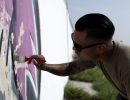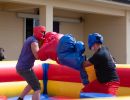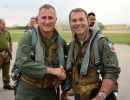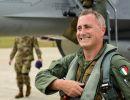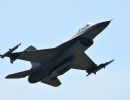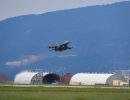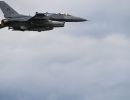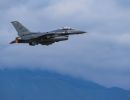Brig. Gen. Timothy Peppe
Commander, 31st Fighter Wing at Aviano Air Base, Italy
Code One: Apr 1998. Vol. 13 No. 2: Pg 30-32.
Brig. Gen. Timothy Peppe, the commander of the 31st Fighter Wing, oversees this ever-changing multinational collection of aircraft. Many of the missions originating from Aviano head to the former Yugoslavia, one of the most politically sensitive regions in the world. Peppe will be the first to admit that his assignment is unique. No other wing commander in the world directs such a diverse multinational force and launches aircraft loaded with live bombs and missiles daily.
Peppe comes to Aviano from an assignment as deputy commander at the headquarters of the 16th Air Force at Vicenza, Italy, where he also directed the Combined Air Operations Center for the 5th Allied Tactical Air Force. The CAOC, as the center is called, is responsible for coordinating all tactical air operations over the former Yugoslavia for NATO. Peppe has more than 3,400 flight hours in various aircraft, including the T-37, T-38, F-4, and F-16. Code One's Eric Hehs visited Peppe at Aviano Air Base in late 1997.
What is the biggest difference between this wing command assignment and others?
Flying with live weapons. We could be called upon at any time by a ground commander to drop a GBU-10 or -12. Every airplane in the wing has some kind of alert commitment year-round.
What international and interservice forces fall under your command?
 We have British AWACS and Spanish F-18s and KC-130 tankers on the base. Canadian F-18s and Air National Guard RC-130s were here last fall. We have some specially equipped EC-130s from the ANG on the ramp. We have air-to-air refueling airplanes and airborne command control and communications aircraft from other services here as well.
We have British AWACS and Spanish F-18s and KC-130 tankers on the base. Canadian F-18s and Air National Guard RC-130s were here last fall. We have some specially equipped EC-130s from the ANG on the ramp. We have air-to-air refueling airplanes and airborne command control and communications aircraft from other services here as well.
We also support the Army two to three times a month. C-130s from the 86th Air Wing land here, unload paratroopers and cargo, and then tactically drop them on a range in Italy east of here. In February, we had a mass tactical drop with twelve C-130s dropping pallets and armament in the afternoon. The aircraft came back, loaded 600 troops, and dropped them that night. Additionally, the Army will station Blackhawk helicopters here by the summer of 1998.
What are some of the implications of being a tenant unit on a foreign air base?
Before I can stick a shovel in the ground, I have to get permission from Col. Orfeo Durigon, the Italian base commander. So far, the Italian Air Force has not objected to what we are doing with the base. We are constantly working with the Italian military on the status of our construction projects. We briefed a NATO Resource Board on our expansion plans. We were given a go-ahead in January for numerous expansion projects. NATO is financing seventy-five percent of our $400 million plus construction program.
What do the expansion plans include?
We will construct a new commissary, base exchange, collocated club for officers and enlisted personnel, fitness center, school, youth center, library, living quarters, transient lodging facilities, security force building, air passenger facility and terminal, and a fighter squadron operations building. This list covers only the major projects, not all the expansion.
Why was Aviano Air Base chosen for this expansion?
Aviano was not designed to handle the population explosion we've seen here in the last few years. I deployed here from Germany with my squadron for weapons training in the mid-1980s. We were the only ones on the base. We did not have to compete with anyone for air space except for an occasional Italian aircraft shooting approaches. The Italian Air Force hasn't flown from Aviano since World War II. The location was chosen because it represents an inexpensive alternative to the Crotone---a site in southern Italy where we were going to move operations from Torrejon, Spain. Building an entire base from scratch in southern Italy would have cost $1.2 billion in 1991 dollars.
What did USAF learn from the 1995 bombing campaign in Bosnia, Operation Deliberate Force?
Deliberate Force proved a few things. It proved that precision-guided munitions are a real factor. We can use fewer sorties to get the same amount of damage while minimizing collateral damage. Intense target study was the key to minimizing collateral damage. The operation also proved that NATO air forces have the ability to work toward a common goal and be highly successful.
What improvements have been made since Deliberate Force?
 We have improved information management within the intelligence community and how that information is shared with the war fighter in real-time or in near-real-time modes. We use information from satellites, U-2 reconnaissance aircraft, Predator imagery, and other information from various intelligence platforms. We can, for example, monitor video from Predator unmanned reconnaissance aircraft in Aviano and at CAOC in real-time.
We have improved information management within the intelligence community and how that information is shared with the war fighter in real-time or in near-real-time modes. We use information from satellites, U-2 reconnaissance aircraft, Predator imagery, and other information from various intelligence platforms. We can, for example, monitor video from Predator unmanned reconnaissance aircraft in Aviano and at CAOC in real-time.
The internal data modem on our F-16s further refines the communication between an ally on the ground and a pilot in the air. The ability the system gives us to find the right target can't be matched: Someone puts a laser on a target; the system provides the pilot with the coordinates and the altitude; the pilot then uses the targeting pod to immediately find the target. This capability makes the task of locating ground targets extremely simple.
The night vision goggles and the Night Vision Imaging System add another dimension to our capability. We now fly night sorties in support of ground commanders. We are the first active duty unit to use NVIS operationally. Flying at night is tough. Everyone I have talked to likes the capability and is amazed at what NVGs allow them to do.
How do pilots keep abreast of the political situation in Bosnia?
Our pilots keep abreast of events in Bosnia through daily intelligence briefings, newspapers, and the Cable News Network.
What missions are F-16 pilots flying today from Aviano?
About a fourth of our missions in the last year went to Bosnia or Albania. About a third of the pilots in the squadron are qualified as forward air controllers. As FACs they work with other airplanes, both US and NATO. Their configuration includes bombs, missiles, and rockets. The resurgence of the FAC mission is an outgrowth of Bosnian operations. Other missions flown from Aviano include normal training missions, consisting of air-to-air and low-level training. We also conduct training sorties at ranges in Germany and Sardinia.
How is the F- 16 performing for you in these various roles?
The Block 40 F-16 is a tremendous asset. The airplane has an immense amount of capability. It is reliable, too. Our mission capable rates are the highest among USAF Block 40 aircraft. The GPS interface greatly enhances our ability to use LANTIRN pods at day and at night.
What improvements in capability would you like to see?
 My predecessors have been responsible for much of the improved capability over the last couple of years. I'd like to see Gold Strike at Aviano. This system allows F-16 pilots to share images with ground-based personnel. I have been pushing this system lately, but even that capability was demonstrated by USAF before I came to Aviano.
My predecessors have been responsible for much of the improved capability over the last couple of years. I'd like to see Gold Strike at Aviano. This system allows F-16 pilots to share images with ground-based personnel. I have been pushing this system lately, but even that capability was demonstrated by USAF before I came to Aviano.

 Visitors to the 31st Fighter Wing at Aviano Air Base in Italy are treated to what amounts to an international air show year-round. Ramps and shelters display a wide variety of aircraft from numerous countries, including Britain, Canada, Germany, Italy, and Spain. F-16s reside permanently at the wing's 510th and 555th Fighter Squadrons. USAFE expeditionary forces, consisting of A-10s from Spangdahlem, Germany, and F-15Es from Lakenheath, England, visit Aviano. The wing hosted a group of Portuguese F-16s last December. The US Marines have a contingent of EA-6B radar jamming aircraft at the base. And F-16s visit from Air National Guard and USAF Reserve units in the United States as rotations allow.
Visitors to the 31st Fighter Wing at Aviano Air Base in Italy are treated to what amounts to an international air show year-round. Ramps and shelters display a wide variety of aircraft from numerous countries, including Britain, Canada, Germany, Italy, and Spain. F-16s reside permanently at the wing's 510th and 555th Fighter Squadrons. USAFE expeditionary forces, consisting of A-10s from Spangdahlem, Germany, and F-15Es from Lakenheath, England, visit Aviano. The wing hosted a group of Portuguese F-16s last December. The US Marines have a contingent of EA-6B radar jamming aircraft at the base. And F-16s visit from Air National Guard and USAF Reserve units in the United States as rotations allow.



























